Fluffy Focaccia Bread Recipe
This easy, no-knead, fluffy focaccia bread recipe makes super airy focaccia bread. The outside is golden and crispy and the inside is airy and light.

This fluffy focaccia recipe is the best focaccia recipe you’ll want to keep up your sleeve. It’s an Italian bread that’s the easiest bread ever to make! Italian focaccia bread can come in various forms, but ultimately it is a yeasted flatbread. Depending on what region of Italy it comes from it can be thin, or thick and fluffy, savory or sweet.
A basic focaccia recipe is made from flour, yeast, water, oil, and salt, but the toppings and flavors vary. It’s very similar to pizza dough, but this rosemary focaccia recipe uses a high hydration dough to create a light and airy bread with the best texture.
Ingredients
The no-knead fluffy focaccia recipe uses a dough made from very basic ingredients. The main flavor of the bread comes from the toppings you choose to top it with. The amounts of the dough ingredients are listed in the recipe card below but here is a quick rundown.
- Flour – bread flour or all-purpose flour can be used in this recipe. Check the protein level, a flour with a protein level of at least 11% is best.
- Water – This dough has very high hydration and a lot of water is used. This focaccia bread is around 84% hydration. It makes traditional kneading a bit hard, so a stretch and fold method will be used.
- Salt – The salt adds flavor and strength to the gluten. Flaky sea salt is also added later as a topping.
- Yeast – instant yeast or active dry yeast can be used. This will create a rise in the focaccia bread. Or you can use sourdough starter and make sourdough focaccia.
- Extra-virgin olive oil – the bread is lavishly coated in a few tablespoons of extra virgin olive oil before it is baked. This creates a fried crust on the outside and adds wonderful flavor.
- Fresh rosemary and olives are the focaccia toppings for this focaccia, though you could substitute them with many other ingredients. Sun-dried tomatoes, capers, cherry tomatoes, other fresh herbs, onions, garlic, or thinly sliced potatoes work well.
The ingredient measurement is provided in grams, using a kitchen scale. This is the most accurate way to measure ingredients for baking.

Baker’s schedule
Here is an example of a baker’s schedule. This can be modified and tweaked to suit your schedule.
Option 1 – Same day no-knead focaccia
- 9 am – 10 15 am – Mix the dough and stretch and fold over an hour.
- 10:15 – 12:00 – Dough is transferred into a prepared pan and left to rise.
- 12: 00 – Topping and baking
Option 2 – Over 2 days
- 3 pm – Mix the dough and perform one set of folds.
- 3:15 pm – Transfer the dough to the fridge overnight
- 9 am next day – Dough is transferred into a prepared pan and left to rise.
- 11:30 am – Topping and baking
Equipment
There isn’t any special equipment or mixer needed for this easy focaccia recipe but you will need a baking pan and a cast-iron skillet to bake it in.
This recipe uses a 12-inch/30cm cast iron skillet, which creates a great fried bottom crust on the focaccia bread. Alternatively, use a 9×13-inch or similar rectangular metal or non-stick baking tray. If your tray isn’t metal or non-stick, you should line it with parchment paper so the focaccia doesn’t stick.
The method
- In a large bowl combine the yeast, lukewarm water, flour, and salt and mix together to create a wet and well-combined (but rough) dough ball.
- Leave it to sit for 15 minutes before applying 4 sets of stretch and folds spread out over an hour, one set every 15 minutes (though this timing isn’t set in stone, don’t worry if it’s less or more!)
- It’s a very wet and sticky dough, so do not feel alarmed if it feels sloppy. It will come together as the stretch and folds continue.

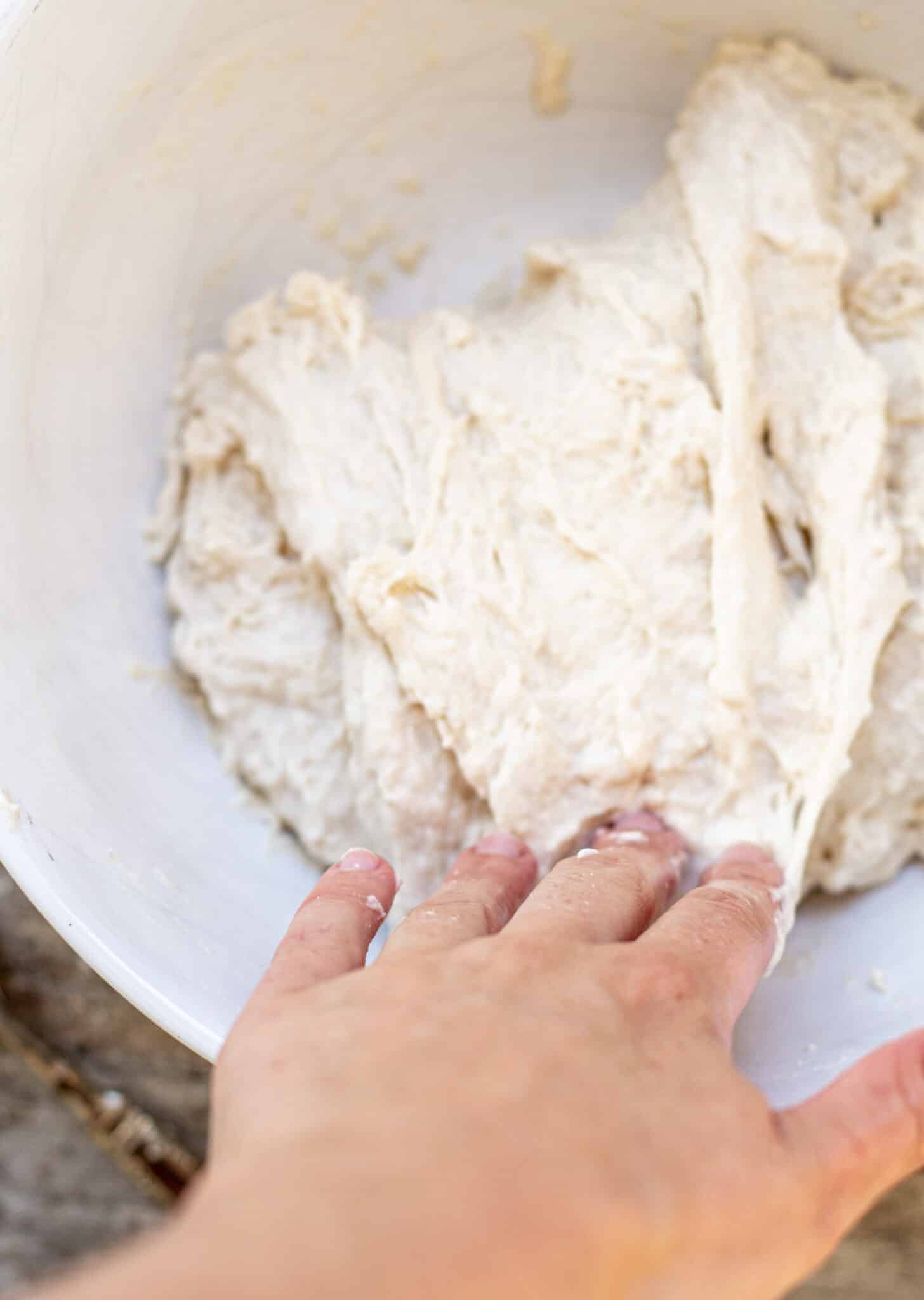
Stretch and folds
A stretch and fold method is when one side of the dough is stretched and pulled over. The bowl is then turned a quarter turn, repeated on the following sides of the bowl. Continue stretching, folding, and turning the bowl until all sides have been folded. That is ‘one set’ of stretch and folds.
The first time you perform a set of stretch and folds, the focaccia dough will be very shaggy and the dough will rip easily. As the folds are carried out over the next while, the gluten structure is created and the dough gains strength.
By the last stretch and fold there will be a significant difference in texture and the dough should be able to stretch up quite high and feel strong. The dough will also be rising during this period and it will feel airier.
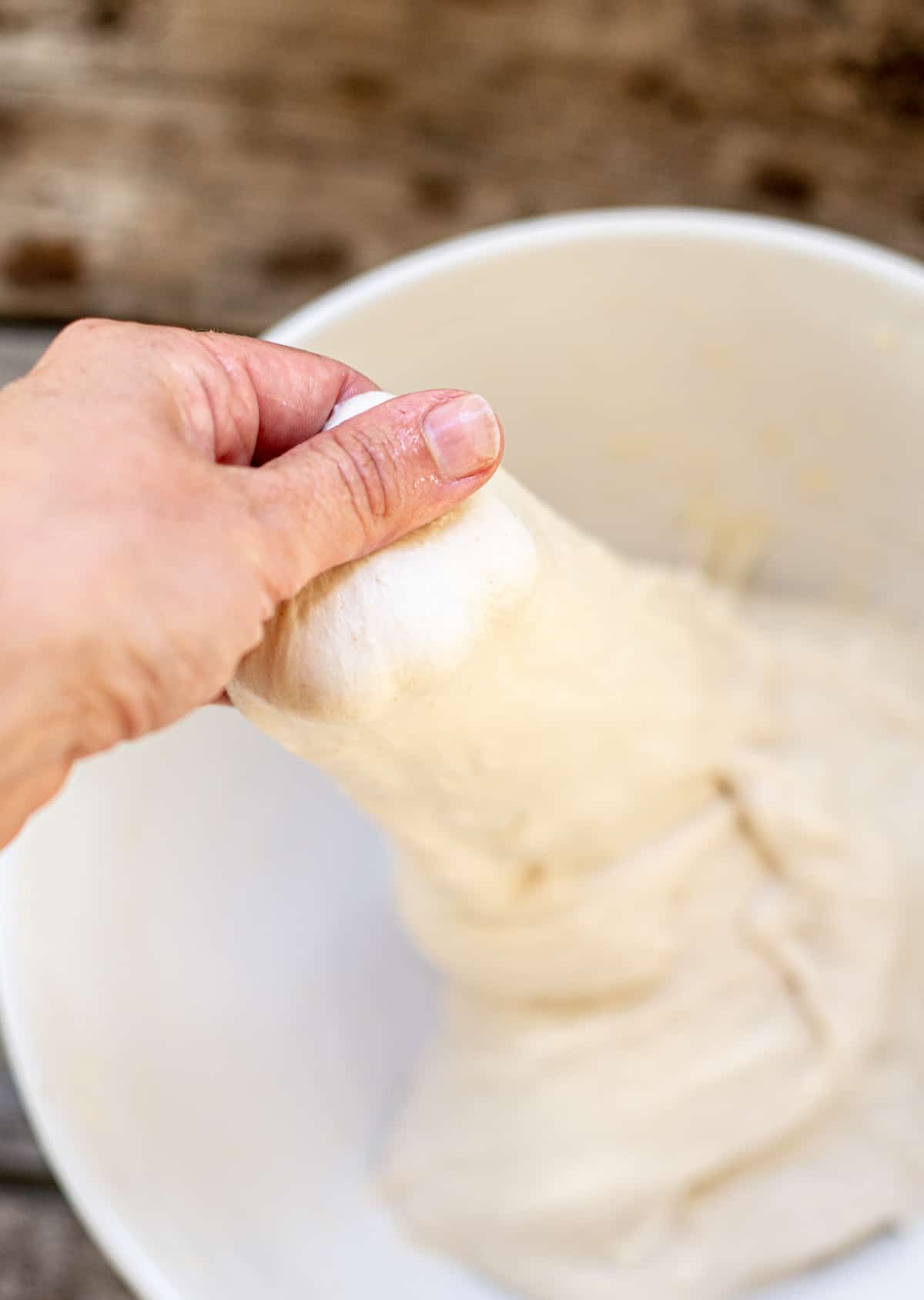
Overnight rest
For overnight focaccia, the dough can be mixed in step one, given one set of stretch and folds, and then transferred to the refrigerator overnight. Stretching develops the gluten in the dough, but a long dough rest does the same thing. Place the dough in a lightly oiled big bowl and cover it with a lid or cling film. It will rise slowly overnight.
The following day, transfer the dough to an oiled skillet or baking tray and carry on with the second rise (instructions below) and dimpling of the dough. When the dough first comes from the refrigerator it will be harder to press into the prepared pan, as cold dough springs back. Let it rest at room temperature before pressing it out to fill the pan.
Second rise
- Drizzle the bottom of the pan or baking tray generously with olive oil (or line with parchment paper.) After the stretch and folds are completed, transfer the dough into the oiled skillet or baking tray. Leave it to sit and rest for 5 minutes, then use oiled fingers to spread the dough out into the skillet.
- Let the dough rise at room temperature for around 1-1.5 hours until it has doubled, and it jiggles when the skillet is shaken. This time will be reduced if the dough is in a warm spot and increased if the room temperature is cold, so it’s always best to watch the dough and not the clock.

- Preheat the oven. Drizzle a couple of tablespoon of olive oil over the surface of the dough, then use oiled fingers to create deep dimples on the top of the dough, pushing down. Do this all over the bread.

- Add over chopped rosemary, sliced olives, and flaky salt. Push the olives and the rosemary so it’s stuck into the focaccia dough.
- Bake the focaccia until puffed and golden brown and the bread pulls away from the edges of the pan. Remove it from the oven and let it sit for 3-4 minutes. Carefully remove it from the skillet or tray, then let it cool further on a wire rack before serving.
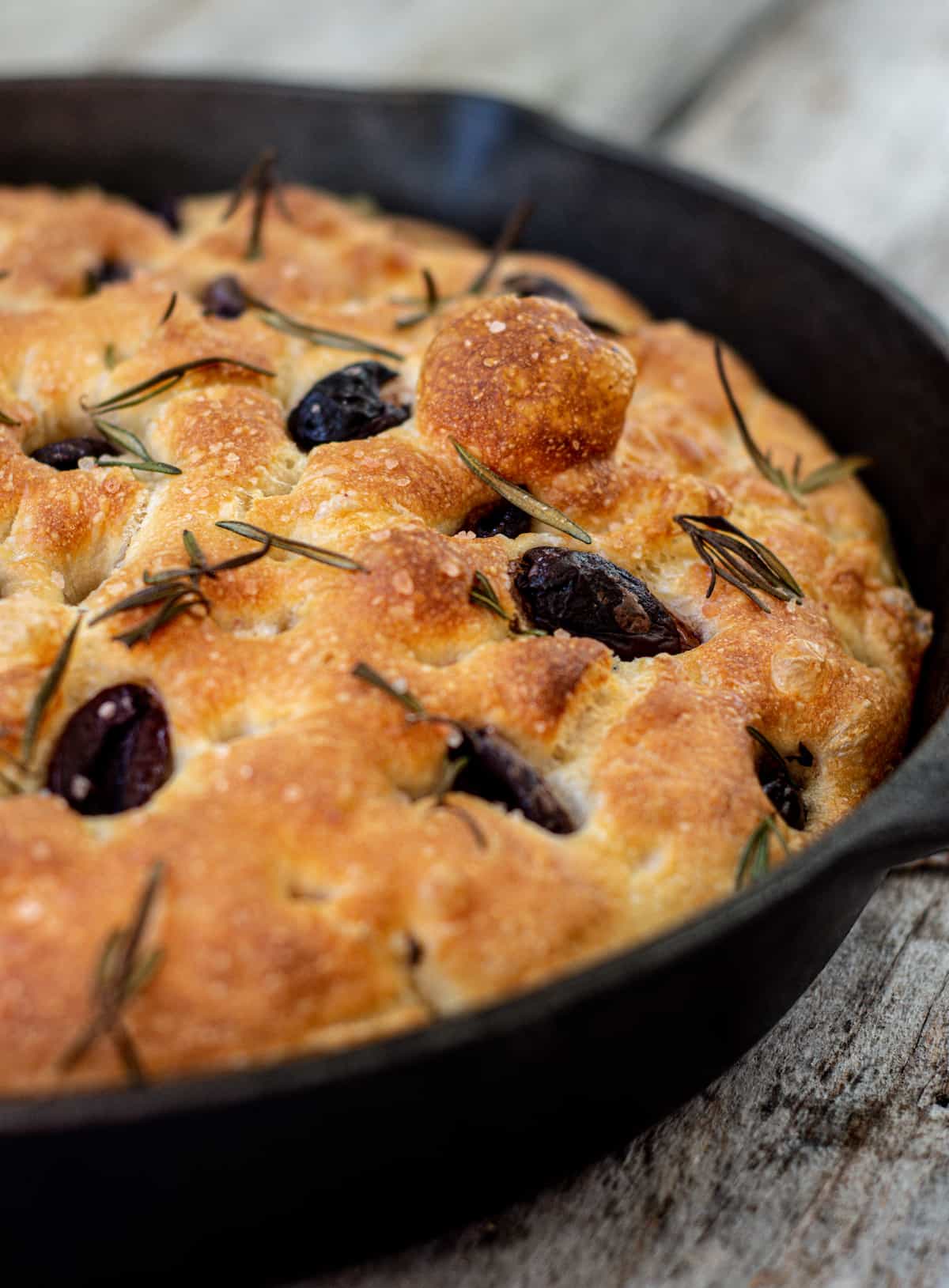
What to eat with focaccia bread
Fresh focaccia bread can be eaten as is as the flavors of olives and rosemary make it delicious all on its own.
Focaccia bread can be used as sandwich bread, or the dough can be spread thinner and used as the perfect base for a pizza. It is an excellent side dish with soups, lasagna, and stews. Use the bread to dip into soups or mop up pasta sauces.
Leftover focaccia bread can be wrapped tightly and stored at room temperature for up to three days. It can also be frozen for up to three months.
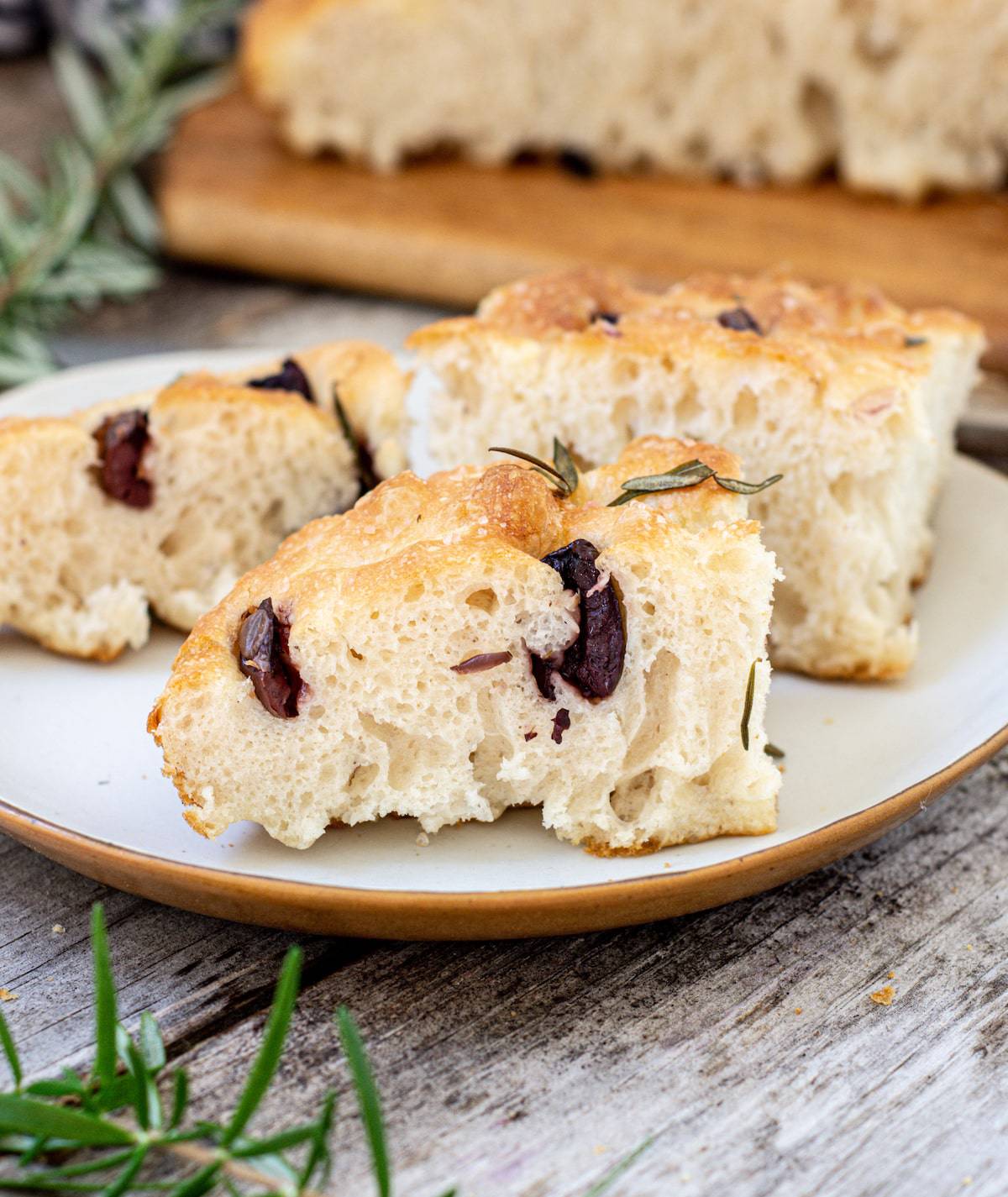
Related recipes
I’ve got a few versions of focaccia on the blog!

No Knead Focaccia Bread Recipe
Ingredients
Dough
- 560 g all-purpose flour or bread flour with a protein level of at least 11%
- 480 g lukewarm water
- 1 1/2 tsp fine salt
- 2 tsp instant or active dried yeast
Topping
- 5-6 Tbsp olive oil
- 1/2 cup chopped Kalamata olives
- 3 Tbsp chopped fresh rosemary
- 1 1/2 tsp flaky salt
Instructions
- In a bowl combine the yeast, water, flour, and salt and mix together to create a wet and well-combined dough. Leave it to sit for 15 minutes before applying 4 sets of stretch and folds spread out over an hour, one set every 15 minutes. Use wet hands when doing this or the dough will stick to you!
- A stretch and fold method is when one side of the dough is stretched up and pulled over itself. The bowl is then turned and this move is repeated on the following side. Continue stretching and folding and turning the bowl until all sides have been folded. That is one set of stretches and folds.
- The first set of stretch and folds will be very shaggy, and the dough will rip easily. As the folds are carried out over the next while, the gluten structure is created, and the dough gains strength. By the last stretch and fold, there will be a significant difference in texture, and the dough should be able to stretch up quite high and feel strong.
- Coat a 12-inch / 30cm cast iron skillet or a 9 x 13-inch / 23x33cm metal or nonstick baking tray with three tablespoons of olive oil. After the stretch and folds are completed, tip the dough into the oiled skillet. Leave it to sit and rest for 5 minutes, then use oiled fingers to spread the dough into the skillet. Leave it to proof at room temperature for 1-1.5 hours until it has doubled, and it jiggles when the skillet is shaken.
- Preheat the oven to 450°F/230°C. Drizzle the remaining 2-3 tablespoons of olive oil over the focaccia, then use oiled fingers to create deep dimples in the dough, pushing all the way down. Do this all over the bread.
- Add over chopped rosemary, sliced olives, and flaky salt.
- Bake the focaccia for around 25-30 minutes until puffed and deep golden brown. Remove it from the oven and carefully remove it from the skillet. Let it cool on a tray for at least 15 minutes before serving.
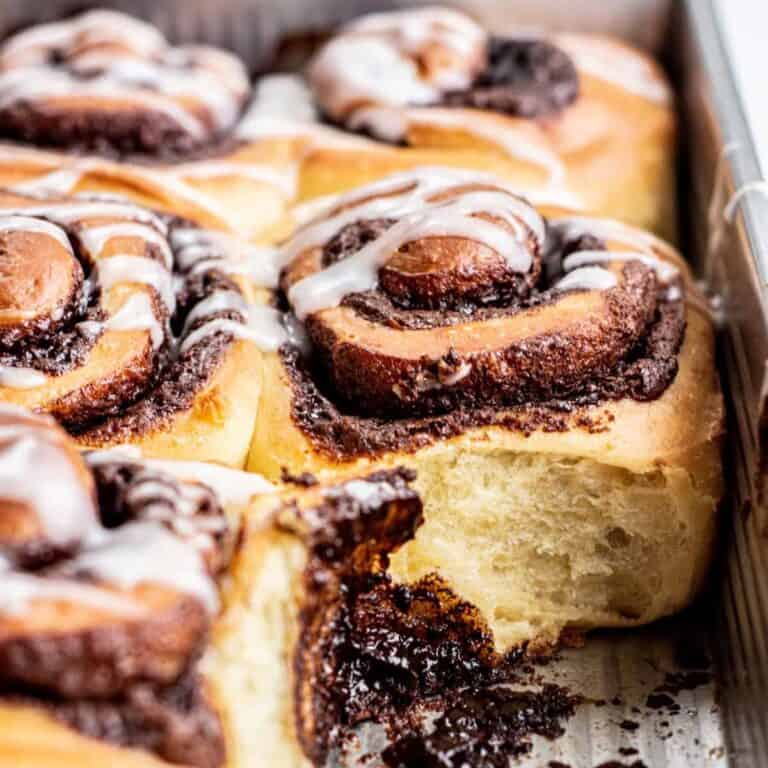


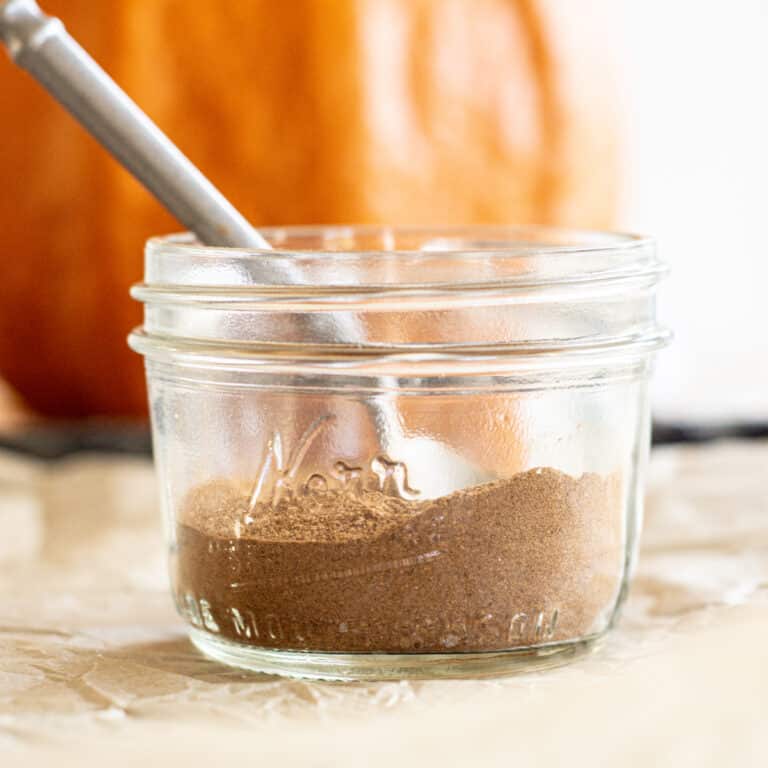


Omg, I love this recipe. This is the lightest and spongey-est focaccia bread I have made. I have made them in the past before and they typically come out dense and dry, not this recipe. Will be keeping this and making again. Thank you 😊
Can you clarify how many sides of dough are folded over in a single stretch and fold?
4 sides of the dough 🙂
This is absolutely the best focaccia I have ever made, and I’ve made a lot. Thank you so much, I’ve made it twice now and my husband is amazed-he’s a bread baker himself.
Yay I’m so happy to read this! Thank you Susan!
Is the dough supposed to be covered while rising during stretch and folds and for the 1-1.5hr rise? TIA!
Out of this world!! This has to be the best recipe for this bread ever!!! Thank you…